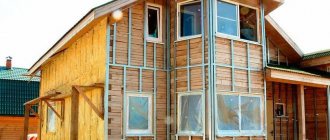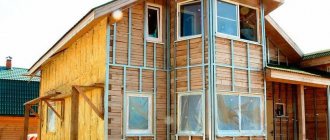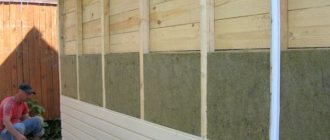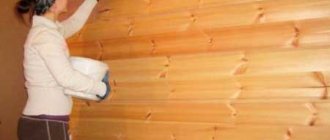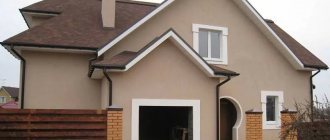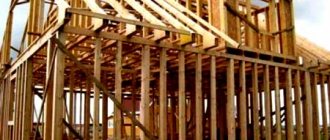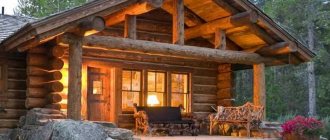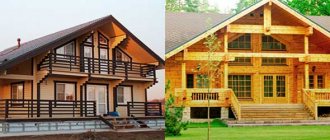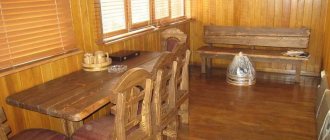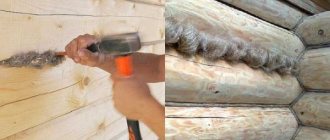The new SNiP for thermal protection, introduced in 2003, imposes strict requirements for the thermal insulation of wooden walls. If previously a house made of timber 200 mm thick or rounded logs with a diameter of 280 mm “fit” into the standards, now they no longer comply with the new standard. Of course, owners of existing buildings may not do anything, but we must take into account that investing in insulating a wooden house is cheap compared to several years of bills for heating and air conditioning. Let's consider how and with what to insulate the outside of a wooden house so that it is of high quality and the house does not lose its environmental properties.
Insulation of wooden walls Source drev-dekor.ru
Insulation methods
According to current standards, there are three types of external wall structures based on the number of layers.
Single layer. Load-bearing and thermal insulation properties are combined at the level of the building material of the enclosing structure. For stone houses, we can give an example of a porous large-format ceramic block or foam concrete block. For frame wooden houses - these are SIP panels.
With a thickness of polystyrene foam in SIP panels from 20 cm, the house will be warm in any frost Source quickhouse.com.ua
As a reference! The new standards are so strict that these walls may also need insulation if the thickness of the base material is insufficient.
Three-layer. Walls in which the outer layer relative to the insulation is structural materials with a thickness of at least 50 mm, fixed to the base with point connections. A classic example is an insulated house lined with brick. You can find such examples of designs of enclosing walls for wooden houses. And in this case, we are talking specifically about brick cladding, since cladding with imitation timber or a block house is by definition not suitable due to the thickness of the outer layer.
Double-layer with external thermal insulation. This is the most common way to insulate a wooden house. Moreover, such a design can be without an air gap or with a ventilated air gap.
Classic scheme of mineral wool insulation with wooden siding cladding Source repair-need.ru
We can talk about four options for how to properly insulate a wooden house from the outside:
- "wet facade";
- curtain façade;
- sprayed thermal insulation
- brick cladding.
The standards indicate another type of construction - with a non-ventilated air gap. But such insulation of a wooden house is not recommended due to the characteristics of the material itself.
Sheathing preparation and installation
When installing the sheathing, you should rely on the thickness of the insulation . The thickness of the bars will be chosen the same. Most often, timber with a thickness of 10-50 mm and a width of 100 mm is selected.
Install the sheathing transversely to the laying of logs with a step between the bars equal to the width of the heat-insulating mats minus 3 centimeters for a tight fit . The height of the sheathing is individual for individual rooms.
Parallel to the laying of logs, the lathing is also installed in the same way (the so-called “counter-lattice”). To install the sheathing, you should choose high-quality material without signs of rotting. Before installation, all wooden parts and surfaces should be treated with an antiseptic.
NOTE!
You should not use thin boards for lathing , since it also serves as a place for attaching finishing coatings.
Lathing
Features of wood as a wall material
Regardless of the structural materials of the walls, when insulating a building it is important to follow the following rules formulated at the SNiP level:
- thermal insulation must be reliably protected from moisture penetration into it;
- access of water vapor to thermal insulation should be limited as much as possible;
- the arrangement of layers should ensure drying of the structure and prevent the accumulation of moisture in it.
The first rule is technically easy to implement. The exterior finish protects from contact with atmospheric moisture, the properties of which can be enhanced with the help of a waterproofing membrane.
Pie wall made of logs outside and inside
When insulating such a household, the owner will need to resolve 2 main problems: increase the heat transfer resistance of wall structures to comply with energy efficiency requirements and create conditions for the removal of moisture accumulated in the heat-protective wall. This process is natural and occurs due to the formation of condensation in air vapor.
The thickness of the insulation directly depends on the calculated heat transfer resistance of the wood species . According to the standards for the Moscow region, the wall of a household with permanent residence must have this indicator not lower than 3.8 m2*C/W. This can be ensured by insulation with a thickness of at least 100-150 mm, respectively for walls 250-200 mm.
The second problem is that ensuring high-quality moisture removal is much more difficult to implement than for brick walls, so experts advise installing a heat insulator on a sheathing with a ventilation gap.
When using mineral wool, a standard pie of external thermal protection for log houses
will consist of the following layers :
- first sheathing;
- vapor barrier with an air gap between the wall;
- one or two layers of insulation;
- superdiffusion membrane;
- second sheathing;
- cladding
For internal thermal insulation, you will need a ventilation gap of at least 3 cm, then install wind and moisture protection, then insulation, followed by a layer of vapor barrier, leave another ventilation gap and then comes the finishing material, for example, 6 mm OSB panels.
Before installing thermal protection you will need:
- carefully caulk the walls, avoiding the formation of “cold bridges”;
- treat with antiseptics against parasites;
- move electrical wires;
- make holes at the bottom and top of the walls for ventilation and removal of moisture and moisture from the heat insulator.
With internal thermal insulation of walls, the effect will be achieved only if the thermal protection of the ceiling and floor is simultaneously carried out in a complex.
Video description
Another option for protecting wood from moisture in the video:
Note! If you look at the websites of leading manufacturers of ready-made systems for plaster and curtain facades (Knauf, Ceresit, Scanroc), none of them have a vapor-tight membrane in their “pie” structure to protect the insulation.
Factory-made façade systems do not provide a vapor-tight membrane between the wall and the insulation. Source derevyannyydom.com
And the same requirements for drying the structure impose restrictions on the choice of insulation.
See also: Catalog of companies that specialize in insulating country houses.
Requirements for the thickness of the wall structure
The optimal thickness of the walls of a log dwelling is such that the room maintains a comfortable temperature regime.
The thickness of the logs for construction depends on the method of use of the room : year-round or seasonal living.
It is also necessary to pay attention to the climatic conditions in the construction region.
A log with a diameter of up to 18 cm is suitable for constructing a gazebo or outbuilding.- A product up to 20 cm is suitable for building a summer kitchen. In some situations, inexpensive cabins are built from them.
- A log with a diameter of 20-22 cm is suitable for constructing a country house.
- For year-round living, it is necessary to build a dwelling from logs with a diameter of about 30 cm.
Attention! If possible, it is better to use thicker logs. It's expensive, but you can save on heating costs.
Video description
We will dwell in more detail on insulating a house with polystyrene foam. Find out how safe polystyrene foam is in our video:
This method of insulation eliminates the possibility of natural ventilation of wooden walls Source remontik.org
Mineral wool best meets the conditions of “drying out the structure”. If we talk about fire safety, then in this parameter it is most suitable for insulating a wooden house. Of the three types of mineral wool, stone wool is usually used. It is more difficult to work with glass wool - when adjusting and installing, small crumbs are formed from fragments of fiberglass, which are dangerous for the skin and respiratory tract. Slag wool is not recommended for insulating residential buildings due to its low environmental qualities.
Sprayed thermal insulation is eco-wool with “wet” technology of application to walls.
This is what the eco-wool insulation technology looks like (wet method) Source remontik.org
Preparatory stage
Before insulating a wooden house from the outside, the facade must be prepared.
There is a standard set of measures for any type of building, which consists of freeing the surface from hanging elements. And there are works typical for a wooden house - checking the condition of inter-crown insulation, caulking (if necessary) and treating with an antiseptic.
Insulating a wooden house does not eliminate the need for caulking of inter-crown joints Source tiu.ru
Preparatory work must be carried out in dry weather. This is especially important for impregnating the top layer of wood with an antiseptic. The treatment process itself consists of applying the solution using the “dying” method, and if the capillaries of the top layer contain water, the antiseptic will not be properly absorbed into the wood.
Treatment with an antiseptic is a mandatory step before insulating and covering wooden walls with façade panels Source ultra-term.ru
See also: Catalog of wooden house projects presented at the Low-Rise Country exhibition.
Features of the “wet facade”
When attaching mineral wool to a wall in the “wet facade” system, an adhesive solution and mechanical fasteners are used. Moreover, glue plays a major role, since the number of metal heat-conducting inclusions in the thermal insulation should be limited. And in order for slabs of hard stone wool mats to be securely fixed, the wall must be fairly flat or have slight differences in “relief” in height, which can be corrected with a layer of adhesive mortar. Only houses made of timber meet this condition.
The surface of log walls must be leveled. This can be done with OSB, moisture-resistant plywood or plasterboard for exterior finishing (the Knauf company recently presented this type of gypsum board). But plywood and OSB do not meet the requirements for vapor permeability of the front finish of a wooden house, and in any case, sheathing is required for leveling. And the use of lathing and additional materials negates the advantage of a “wet facade” over a ventilated one - its relatively low cost.
They use a “wet facade” for additional insulation of frame houses. And if one of the types of polymer materials was used as the internal insulation of the thin-sheet construction of the enclosing surfaces, then foam plastic can be used for external insulation - it will not impair the vapor permeability of the walls.
You can also insulate a frame house with polystyrene foam Source stroyew.ru
There are also some peculiarities in the methods of attaching insulation to wooden walls, when self-tapping screws are used instead of dowels, and the adhesive solution is highly elastic.
Otherwise, the insulation technology has a standard sequence of work:
- A starting strip is attached along the perimeter of the base (grillage).
- Install the bottom row of stone wool mats. Use glue and at least 5 pcs. self-tapping screws per 1 m².
- When installing the next rows, the vertical seams are shifted by at least 20 cm.
- Window and door openings in the corners should not have intersecting seams of insulation sheets.
- The surface is reinforced with fiberglass mesh, and the corners are reinforced with perforated corners. An adhesive solution is used to fix the reinforcing elements.
- A layer of mortar is again applied on top of the mesh (the total thickness should be about 6 cm), the surface is leveled, and after drying, it is sanded.
- The façade is being plastered and painted.
When will you need to insulate a log building?
Often the cold in a log building is associated with errors in the installation of doors and windows.
The main indicators of the need for additional home insulation are:
- the appearance of drafts;
- rapid decrease in temperature in the room after turning off the heating;
- cold walls.
Important! It is not recommended to insulate the building from the outside until the house has completely settled.
Heat loss can occur not only through windows and doors, but also through other places:
- Ceiling . To retain heat, it is necessary to insulate the attic.
- Floor . It is necessary to reduce basement ventilation.
- Walls . It happens that the walls do not correspond to climatic conditions. Depending on the climate in the region, the thickness of the walls should be either greater or less.
How to insulate a wooden house with polystyrene foam
If desired, you can find examples of using polystyrene foam to insulate a wooden house from the outside. Moreover, there is a technology that does not impair the “breathing” properties of the walls and the level of comfort, which is ensured due to natural gas exchange between rooms and the street. This is achieved by creating a ventilated gap between the insulation and the wall. Moreover, in this case, it does not matter what the walls are made of - timber or logs.
In order not to worsen the “breathing” properties of a wooden house, a ventilated gap must be created between the foam plastic and the wall Source bouw.ru
Main nuances
External insulation of a house is a very effective measure, but its use does not allow preserving the house in its original form. Therefore, it is advisable to use it only in extreme cases when other methods are ineffective.
First, you should still try to insulate the structure from the inside; you need to find and caulk all the cracks. After this, you can take drastic measures and insulate the building using the same insulation. At the same time, the technologies for insulating a house from the outside and inside are almost similar.
Features of the curtain façade
In this case, the requirements for the peel strength of the insulation surface are not as high as for a “wet facade”, so the density of the mats can be less than 125 kg/m³, but higher than 80 kg/m³.
Attention! When choosing how to insulate a wooden house from the outside, you need to know that the use of rolled mineral wool in curtain wall facades is not recommended by regulatory documents.
There are ready-made systems of curtain facades with their own fastening subsystem, a set of panels and fasteners. The only drawback of such systems is the need for individual adjustment to the specific geometry of the house and walls. As a rule, these systems are designed for houses made of brick or building blocks, and aluminum sandwich panels, artificial stone, and porcelain stoneware are used as cladding.
For cladding wooden houses, imitation timber, block house, planken, and siding are usually used. That is, those materials that are more consistent with the aesthetics of a wooden house.
If you want to change the decorative qualities of a wooden house, you can use facade panels made of artificial stone for cladding. Source stroyfora.ru
The most common practice is to make lathing from wooden beams - it is easy to adapt to the surface of the walls, it is easier to fasten, it does not change size due to temperature changes and does not serve as a “cold bridge”.
Wooden sheathing is the simplest option Source otopleniehouse.ru
The only drawback of wooden structures is their low resistance to moisture. Therefore, both the sheathing elements and finishing panels made of natural wood must be treated with an antiseptic before installation.
Sealing seams and joints of forming elements
This method is internal wall insulation aimed at sealing joints and cracks in logs . In this case, various sealants are used (silicone, latex, acrylic, linen rope, tow). This method is convenient because it can be easily done with your own hands and does not require special skills, it does not interfere with the release of steam and is the most economically profitable.
Technically it is carried out as follows:
- the edges of joints and cracks are cleaned,
- cavities are filled with rope, foam rubber;
- a layer of sealant is applied on top;
- the sealant is smoothed with a brush until a smooth surface is formed;
- Remains of sealant are removed with a rag.
Sealing with sealant
Sealing seams with fabric
As a result, what other options can you consider?
The article described only the two most common ways to insulate a wooden house from the outside. The better it will be in your case and other options should be discussed with a developer who knows local conditions. The use of eco-wool has not yet become widespread, although the technology is quite simple - installing the sheathing to the wall, applying insulation to the surface in a “wet” form (mixed with glue) using special equipment, and covering the sheathing with facade panels. Cladding with flexible bricks follows the same rules as for a stone house, with the only limitation on the choice of insulation - the use of only mineral wool.
Despite the apparent simplicity of the entire process, when installing any type of insulation there are a sufficient number of pitfalls that must be taken into account so that all the work is not done in vain. If you have no experience, then it is always better to invite a professional, especially since self-respecting developers perform all work under a contract and give a guarantee.

